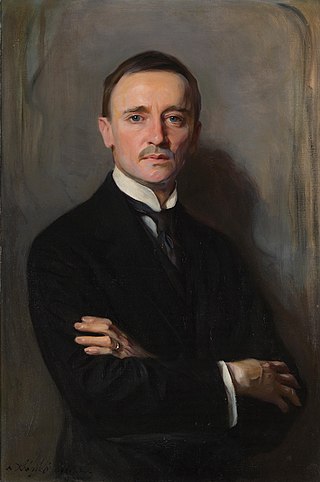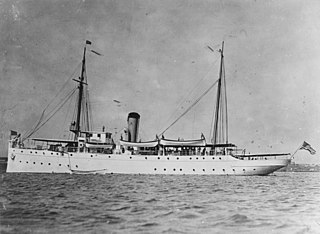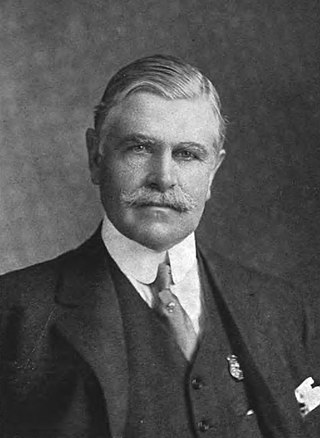
Norman Hackerman was an American chemist, professor, and academic administrator who served as the 18th President of the University of Texas at Austin (1967–1970) and later as the 4th President of Rice University (1970–1985). He was an internationally known expert in metal corrosion.

Admiral of the Fleet Sir Frederick Charles Doveton Sturdee, 1st Baronet was a Royal Navy officer. After training as a torpedo officer, he commanded two different cruisers and then three different battleships before becoming commander of the 1st Battle Squadron of the Home Fleet. He went on to command the 3rd Cruiser Squadron and then the 2nd Cruiser Squadron.

Elmer Ambrose Sperry Sr. was an American inventor and entrepreneur, most famous for construction, two years after Hermann Anschütz-Kaempfe, of the gyrocompass and as founder of the Sperry Gyroscope Company. He was known as the "father of modern navigation technology".

Charles Francis Adams Jr. was an American author, historian, and railroad and park commissioner who served as the president of the Union Pacific Railroad from 1884 to 1890. He served as a colonel in the Union Army during the American Civil War. After the war, he was a railroad regulator and executive, an author of historical works, and a member of the Massachusetts Park Commission.

Ben Hebard Fuller was a major general in the United States Marine Corps and served as the 15th Commandant of the Marine Corps between 1930 and 1934.

Frank Friday Fletcher was a United States Navy admiral who served in the late 19th and early 20th centuries. He was awarded the U.S. military's highest decoration, the Medal of Honor, for his actions as commander of navy forces at the Battle of Veracruz, Mexico. The Fletcher-class destroyer, the most produced class of United States Navy destroyers, was named after him. He was also the uncle of Frank Jack Fletcher, another U.S. Navy Admiral who also received the Medal of Honor for actions at Veracruz, and who commanded U.S. naval forces at the battles of Coral Sea and Midway during the Second World War.

Cameron McRae Winslow served in the United States Navy during the Spanish–American War and World War I. A son of Commander Francis Winslow (I) (1818–1862),

Admiral of the Fleet Rosslyn Erskine Wemyss, 1st Baron Wester Wemyss,, known as Sir Rosslyn Wemyss between 1916 and 1919, was a Royal Navy officer. During the First World War he served as commander of the 12th Cruiser Squadron and then as Governor of Moudros before leading the British landings at Cape Helles and at Suvla Bay during the Gallipoli campaign. He went on to be Commander of the East Indies & Egyptian Squadron in January 1916 and then First Sea Lord in December 1917, in which role he encouraged Admiral Roger Keyes, Commander of the Dover Patrol, to undertake more vigorous operations in the Channel, ultimately leading to the launch of the Zeebrugge Raid in April 1918.

The Naval Consulting Board, also known as the Naval Advisory Board, was a US Navy organization established in 1915 by Josephus Daniels, the Secretary of the Navy at the suggestion of Thomas Alva Edison. Daniels created the Board with membership drawn from eleven engineering and scientific organizations two years before the United States entered World War I to provide the country with the "machinery and facilities for utilizing the natural inventive genius of Americans to meet the new conditions of warfare." Daniels was concerned that the U.S. was unprepared for the new conditions of warfare and that they needed access to the newest technology.

Admiral of the Fleet Sir Henry Bradwardine Jackson, was a Royal Navy officer. After serving in the Anglo-Zulu War he established an early reputation as a pioneer of ship-to-ship wireless technology. Later he became the first person to achieve ship-to-ship wireless communications and demonstrated continuous communication with another vessel up to three miles away. He went on to be Third Sea Lord and Controller of the Navy, then Director of the Royal Naval War College and subsequently Chief of the Admiralty War Staff. He was advisor on overseas expeditions planning attacks on Germany's colonial possessions at the start of the First World War and was selected as the surprise successor to Admiral Lord Fisher upon the latter's spectacular resignation in May 1915 following the failure of the Gallipoli Campaign. He had a cordial working relationship with First Lord of the Admiralty Arthur Balfour, but largely concerned himself with administrative matters and his prestige suffered when German destroyers appeared in the Channel, as a result of which he was replaced in December 1916.

Erasmus Darwin Leavitt Jr., also known as E. D. Leavitt, was a noted American mechanical engineer best known for his steam engine designs.

Austin Melvin Knight was an admiral in the United States Navy. He was commander in chief of the U.S. Asiatic Fleet from 1917 to 1918. His 1901 textbook Modern Seamanship was a standard reference for over eight decades.

William Richards Castle Jr. was an American educator and diplomat. He rose rapidly to the highest levels of the United States Department of State and took a strong interest in Pacific issues, in part because of his family's background in Hawaii.

USCGC Tampa (ex-Miami) was a Miami-class cutter that initially served in the U.S. Revenue Cutter Service, followed by service in the U.S. Coast Guard and the U.S. Navy. Tampa was used extensively on the International Ice Patrol and also during the Gasparilla Carnival at Tampa, Florida and other regattas as a patrol vessel. It was sunk with the highest American naval combat casualty loss in World War I.

The General Board of the United States Navy was an advisory body of the United States Navy, somewhat akin to a naval general staff and somewhat not. The General Board was established by general order 544, issued on March 13, 1900 by Secretary of the Navy John Davis Long. The order was officially recognized by Congress in 1916. The General Board was disbanded in 1951.

William John Maxwell was a United States Navy officer who served as the 18th Naval Governor of Guam. He entered the United States Naval Academy in 1874, but was not commissioned as an ensign until 1883. He served aboard many ships before becoming one of the inaugural members of the General Board of the United States Navy. Afterward, he commanded both USS Mississippi and USS Florida.

William Lawrence Saunders was a mining engineer who was chairman of the Naval Consulting Board during World War I. He was chairman of the board of Ingersoll Rand.
Andrew Murray Hunt was an American electrical and mechanical engineer who served on the Naval Consulting Board during the First World War and was president of the American Society of Civil Engineers in 1921 and 1922. His obituary in The New York Times describes him as "nationally eminent".

Louis Richmond Cheney (1859–1944) was a businessman and political figure from Connecticut.

Lawrence Clifton Gorman was an American Catholic priest and Jesuit who held senior positions at several Jesuit universities in the United States. Born in New York City, he was educated at Jesuit institutions, before entering the Society of Jesus. He then became a professor of chemistry at Georgetown University, and continued his higher studies at Jesuit universities in the United States and Rome.



















